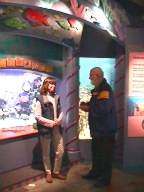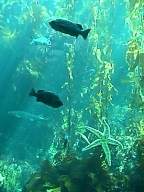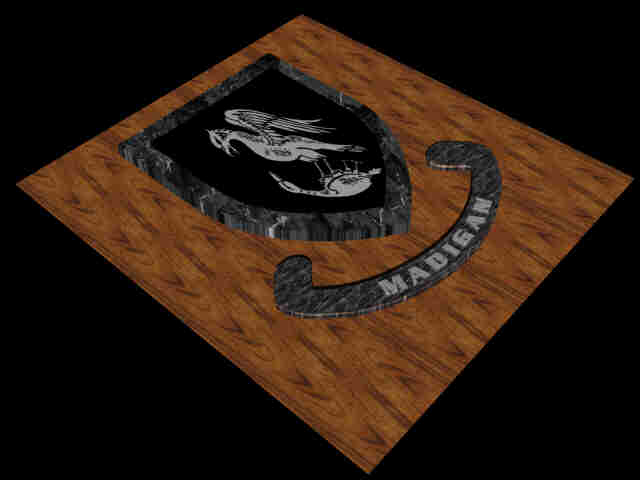Monterey Bay
Aquarium
On Historic
Cannery Row
Monterey, CA
November 1, 2000
In 1990,  while still
finishing up my last few years of gainful employment, I received
my February issue of National Geographic Magazine. For the next
hour, this magazine kept me intrigued with its story of Monterey
Bay, California. As life went on and I retired and began to
travel, this article never left my memory. It sounded like a
delightful place to visit. When the chance came we jumped on it,
doing many stories in and around the Bay. My favorite place in
all the sixty-some miles of Bay area will always be the city of
Monterey and "Cannery Row", made famous in the book
with the same name written by John Steinbeck.
while still
finishing up my last few years of gainful employment, I received
my February issue of National Geographic Magazine. For the next
hour, this magazine kept me intrigued with its story of Monterey
Bay, California. As life went on and I retired and began to
travel, this article never left my memory. It sounded like a
delightful place to visit. When the chance came we jumped on it,
doing many stories in and around the Bay. My favorite place in
all the sixty-some miles of Bay area will always be the city of
Monterey and "Cannery Row", made famous in the book
with the same name written by John Steinbeck.  The
marine biological wonderland that supports this area is caused by
a massive deep sea canyon, as deep as the Grand Canyon of
Arizona. Just off shore, the cold waters from far below up-welled
carrying nutrients to the sardines above. These nutrients also
fed the kelp forests which shelters a myriad of sea life. Up
until the end of WW II the area was fished with reckless
disregard to the requirements of nature.
The
marine biological wonderland that supports this area is caused by
a massive deep sea canyon, as deep as the Grand Canyon of
Arizona. Just off shore, the cold waters from far below up-welled
carrying nutrients to the sardines above. These nutrients also
fed the kelp forests which shelters a myriad of sea life. Up
until the end of WW II the area was fished with reckless
disregard to the requirements of nature.  This was especially dramatic with the sardine
industry. Dozens of sardine canneries popped up right besides one
another, giving way to a thriving industry teaming with the life
of the fisherman. It was in this world that John Steinbeck
studied the human relationships reflected in his literary
masterpiece. Finally, as with most things approached with
reckless abandonment, the sardines were gone. Fished out, along
with most other commercial products from the area. The canneries
shut down and were abandoned and the area suffered economic
depression.
This was especially dramatic with the sardine
industry. Dozens of sardine canneries popped up right besides one
another, giving way to a thriving industry teaming with the life
of the fisherman. It was in this world that John Steinbeck
studied the human relationships reflected in his literary
masterpiece. Finally, as with most things approached with
reckless abandonment, the sardines were gone. Fished out, along
with most other commercial products from the area. The canneries
shut down and were abandoned and the area suffered economic
depression.
It was with the knowledge of this history, that in 1977 four
marine biologists at Stanford University's  Hopkins Marine Station in Pacific Grove, sat
around a table doodling on napkins with designs for creating an
Aquarium out of the abandoned Hovden Cannery nearby. Their ideas
may have lain dormant forever as the dreams of many others have,
except one of the biologists was Nancy Packard, one of David
Packard's (of the Hewlett Packard Company) two daughters. With
her father and sister, Julie
Hopkins Marine Station in Pacific Grove, sat
around a table doodling on napkins with designs for creating an
Aquarium out of the abandoned Hovden Cannery nearby. Their ideas
may have lain dormant forever as the dreams of many others have,
except one of the biologists was Nancy Packard, one of David
Packard's (of the Hewlett Packard Company) two daughters. With
her father and sister, Julie  coming on board, the idea took off and in 1984,
after a one time infusion of some $55 million of the
family's money, the Monterey Bay Aquarium opened its door to the
public, with Julie Packard as Executive Director, and the rest is
history. Our contact at the
coming on board, the idea took off and in 1984,
after a one time infusion of some $55 million of the
family's money, the Monterey Bay Aquarium opened its door to the
public, with Julie Packard as Executive Director, and the rest is
history. Our contact at the  Aquarium was Karen Jeffries, a wonderful young
lady who had agreed to show us around the attraction. Through her
insight, we followed the development of a massive endeavor to
bring to light, the secrets of the deep in Monterey Bay. The
impression received coming through the front door was one that
will last a life time. A huge aquarium tank, 30 feet deep
displaying the centerpiece of Bay life, the long dangling kelp
plants gently swaying in the current, while a myriad of
Aquarium was Karen Jeffries, a wonderful young
lady who had agreed to show us around the attraction. Through her
insight, we followed the development of a massive endeavor to
bring to light, the secrets of the deep in Monterey Bay. The
impression received coming through the front door was one that
will last a life time. A huge aquarium tank, 30 feet deep
displaying the centerpiece of Bay life, the long dangling kelp
plants gently swaying in the current, while a myriad of fish darted
in and around the forest of seaweed. Current? That's correct. The
Aquarium has a surge machine that gives life to this most unusual
fish tank. From its conception, the Monterey Bay Aquarium
exhibits were designed to represent a living extension of
Monterey Bay - the centerpiece of the nation's largest national
marine sanctuary which now features more then 300,000 creatures
representing more then 570 species of plants and animals from the
waters of the central California coast. Seawater from the bay is
piped into the aquarium at a rate of 2 thousand gallons per
minute to sustain the three story living kelp forest.
fish darted
in and around the forest of seaweed. Current? That's correct. The
Aquarium has a surge machine that gives life to this most unusual
fish tank. From its conception, the Monterey Bay Aquarium
exhibits were designed to represent a living extension of
Monterey Bay - the centerpiece of the nation's largest national
marine sanctuary which now features more then 300,000 creatures
representing more then 570 species of plants and animals from the
waters of the central California coast. Seawater from the bay is
piped into the aquarium at a rate of 2 thousand gallons per
minute to sustain the three story living kelp forest.
